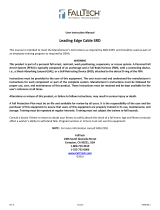Page is loading ...

EDGE Application Guide Page 1 of 2
How to Extract PFAS from Samples using the EDGE 2021-01
www.cem.com © 2018 CEM Corporation
All rights reserved. This may not be reproduced or published without written permission from CEM.
How to Extract PFAS from Samples using the EDGE
Introduction
Consumers and regulatory bodies are becoming increasingly concerned about the level of PFAS in products used for daily use as well
as the environment. PFAS compounds are known to cause health issues, and their extractions are difficult because of their widespread
nature. Please use this method and its suggestions to extract PFAS compounds from various samples using the EDGE. Note: This
method requires the PFAS version of the EDGE. This version of the EDGE has PEEK tubing for solvent lines, polypropylene
tubing along its fluidic pathway, and software limitations compared to the typical EDGE. Please ensure that you are using a
PFAS EDGE before proceeding.
Sample Types
Soil, food, food packaging
EDGE Preparation
1. Prepare the EDGE by priming a solvent line with your PFAS-free solvent of choice. CEM recommends using 80:20
methanol:water with 0.3% ammonium hydroxide.
Note: Please use HPLC-grade solvents or solvents previously known to be PFAS-free for cleaning the EDGE and for
the extraction of PFAS compounds. Also, the PFAS version of the EDGE has a limited solvent selection.
2. Perform at least 6 system washes at 65 °C before running a sample.
3. Rinse Q-Cups provided with same solvent. Allow them to dry.
EDGE Extraction
4. Assemble a Q-Cup with the S1 stack (C9+G1+C9).
Note: CEM recommends using the S1 Q-Disc stack for PFAS extractions.
5. Load the rack with a conical tube.
Note: Please use polypropylene conical tubes. This material is shown to be generally PFAS-free.
6. Using the assembled Q-Cup with no added sample, extract the empty Q-Cup using the EDGE method at the bottom of this
protocol.
7. Remove the conical tube from the rack. Transfer sample to HPLC vial, and analyze using LC-MS.
Note: Please confirm that the extract is PFAS-free. If there are still contaminating PFAS compounds, please repeat
steps 2 and 3 until blank extraction shows clean background.
8. Assemble a Q-Cup with the S1 stack.
9. Weigh 2-5 g of sample into the Q-Cup directly.
Note: Is the sample wet? If so, please add 2.5 g of Q-Matrix Hydra per 5 g of wet sample to the Q-Cup first before
weighing the sample. Is the sample high fat? If so, please add 0.5 g of C18 per 5 g of sample to the Q-Cup first before
weighing the sample.
10. Place the Q-Cup and a polypropylene conical tube in the EDGE rack.
Note: Please use polypropylene conical tubes as the collection vial. CEM supplies these PFAS-free.
11. Extract the sample using the EDGE method at the bottom of this page.
Cycle Solvent Top add
(mL)
Bottom add
(mL)
Rinse
(mL)
Temperature
(°C)
Hold
(mm:ss)
1 80:20 Methanol:Water with
0.3% Ammonium Hydroxide
10 0 0 65 03:00
2 80:20 Methanol:Water with
0.3% Ammonium Hydroxide
10 0 0 65 04:00
Wash 1 Methanol 10 - - 50 --:--
Wash 2 80:20 Methanol:Water with
0.3% Ammonium Hydroxide
10 - - - --:--

EDGE Application Guide Page 2 of 2
How to Extract PFAS from Samples using the EDGE 2021-01
© 2018 CEM Corporation
Post Extraction Work Up
12. Remove the extract vial from the rack.
13. Confirm volume of extraction.
14. Transfer sample to HPLC vial, and analyze using LC-MS.
Method Development Tips
• Please take the proper precautions to make sure your EDGE is PFAS-free prior to analysis. Please use gloves when handling
all samples. Please confirm that solvents and sorbents used are PFAS-free.
• Other extraction solvents, such as pure methanol, can be used. However, the PFAS version of the EDGE has limited solvent
selection. If you need another solvent option, please reach out to Molecular Support.
• If optimal recovery is not achieved, consider increasing hold time or solvent volume. Also, confirm that the sample was
properly homogenized prior to extraction. Additionally, the Agitation feature on the EDGE can be used to further mix the
sample. Please reach out to Molecular Support for more details.
/


